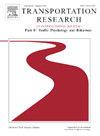Drivers’ acceptance of adaptive warning–monitoring systems. Findings from a car driving simulator study
IF 3.5
2区 工程技术
Q1 PSYCHOLOGY, APPLIED
Transportation Research Part F-Traffic Psychology and Behaviour
Pub Date : 2024-11-01
DOI:10.1016/j.trf.2024.10.005
引用次数: 0
Abstract
Private vehicles are nowadays often equipped with advanced driver assistance systems (ADAS) that aim to assist drivers in maintaining safe driving behavior. Understanding users’ acceptance and perceptions towards them is therefore crucial, mostly before developing or implementing additional assistance features. Driving simulators provide a unique opportunity to test ADAS in a controlled environment, in particular when safety–critical situations need to be replicated in a way that is not possible on real roads. In this study, an advanced warning–monitoring system, developed in the context of the recent European–wide naturalistic driving study (i–DREAMS1), is implemented in a driving simulator environment, so that is tested before it is then deployed in vehicles on real roads. For this purpose, a driving simulator study was conducted in Germany, in which 60 drivers participated. The study included three drives: the first was a baseline drive in which in–vehicle warnings were not activated, the second included real–time warnings (interventions), and the third had an additional distraction component, introduced by means of a mobile phone texting task (imposed on participants). Drivers were also asked to fill various questionnaires focusing on their perceptions towards general ADAS and driving, but also towards the implemented system (the i–DREAMS system2). A statistical analysis of the questionnaire results led to the partial validation of the technology acceptance model (TAM) for the i–DREAMS system, for which perceived usefulness (PU) and perceived ease of use (PEU) of the system, both of which resulted from a factor analysis of the attitudinal questions, were found to be crucial factors for the behavioral intention to use it. In the validated TAM, PU of the i–DREAMS system was found to be positively impacted by external variables, namely PU of similar ADAS systems, whereas PEU was found to be positively influenced by driving experience. While the system was overall positively received, findings and lessons learned from the experiment were transferred to future field experiments conducted within the same project, and suggested more generally that driving simulator studies could be very beneficial for testing newly developed in–vehicle technologies, leading on the long run to safer roads.
驾驶员对自适应预警监测系统的接受程度。汽车驾驶模拟器研究结果
如今,私家车通常都配备了先进的驾驶员辅助系统(ADAS),旨在帮助驾驶员保持安全的驾驶行为。因此,了解用户对这些系统的接受程度和看法至关重要,尤其是在开发或实施附加辅助功能之前。驾驶模拟器为在受控环境中测试 ADAS 提供了一个独特的机会,尤其是在需要复制真实道路上无法复制的安全关键情况时。在本研究中,在最近进行的全欧洲自然驾驶研究(i-DREAMS1)的背景下开发的先进预警监测系统在驾驶模拟器环境中实施,以便在实际道路上部署车辆之前进行测试。为此,在德国进行了一次驾驶模拟器研究,共有 60 名驾驶员参加。研究包括三次驾驶:第一次是基线驾驶,在此过程中不启动车内警告;第二次包括实时警告(干预);第三次是额外的分心部分,通过手机短信任务(强加给参与者)的方式引入。驾驶员还被要求填写各种调查问卷,重点了解他们对一般 ADAS 系统和驾驶的看法,以及对已实施系统(i-DREAMS 系统2)的看法。通过对问卷结果进行统计分析,部分验证了 i-DREAMS 系统的技术接受模型(TAM),其中系统的有用性感知(PU)和易用性感知(PEU)是影响使用该系统的行为意向的关键因素。在经过验证的 TAM 中,i-DREAMS 系统的易用性受外部变量(即类似 ADAS 系统的易用性)的积极影响,而 PEU 则受驾驶经验的积极影响。虽然该系统总体上受到好评,但从实验中得出的结论和经验教训也被应用到了未来在同一项目内进行的实地实验中,并且更广泛地表明,驾驶模拟器研究对于测试新开发的车载技术非常有益,从长远来看,可以提高道路的安全性。
本文章由计算机程序翻译,如有差异,请以英文原文为准。
求助全文
约1分钟内获得全文
求助全文
来源期刊
CiteScore
7.60
自引率
14.60%
发文量
239
审稿时长
71 days
期刊介绍:
Transportation Research Part F: Traffic Psychology and Behaviour focuses on the behavioural and psychological aspects of traffic and transport. The aim of the journal is to enhance theory development, improve the quality of empirical studies and to stimulate the application of research findings in practice. TRF provides a focus and a means of communication for the considerable amount of research activities that are now being carried out in this field. The journal provides a forum for transportation researchers, psychologists, ergonomists, engineers and policy-makers with an interest in traffic and transport psychology.

 求助内容:
求助内容: 应助结果提醒方式:
应助结果提醒方式:


